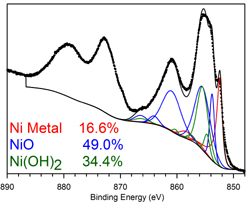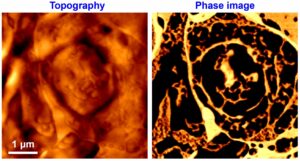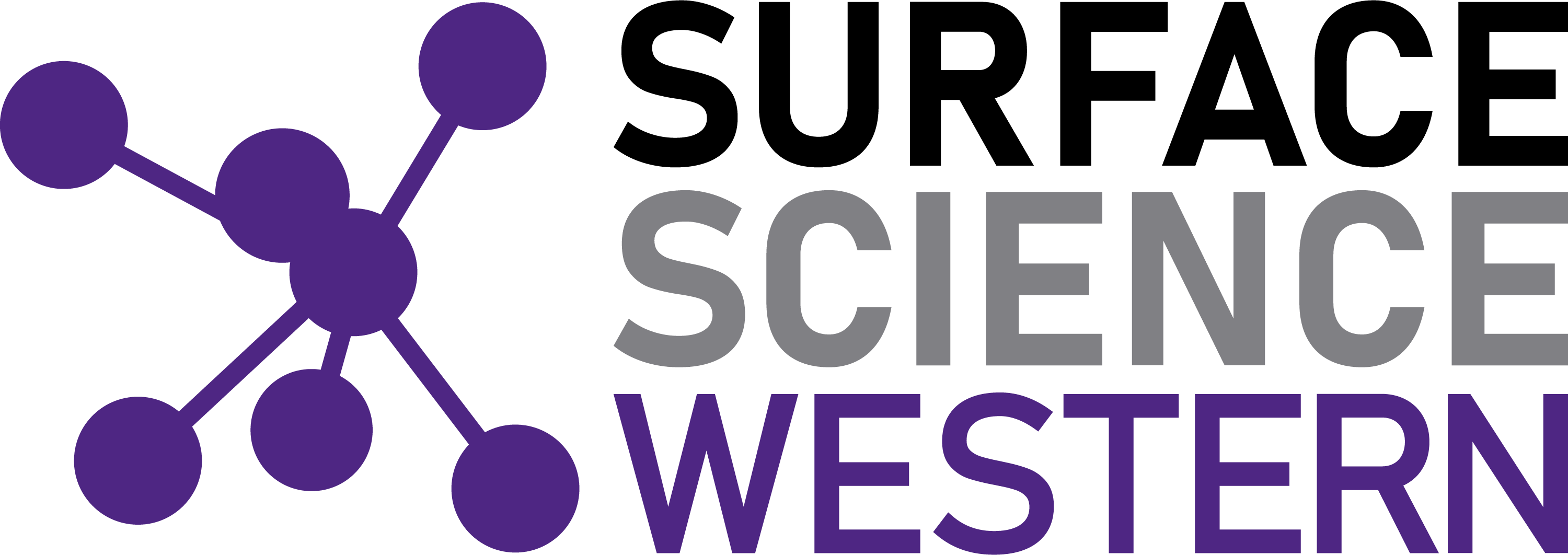Near‑technical limit gold recovery from a double refractory carlin‑type ore after pre‑treatment by high‑temperature pressure oxidation, D. Dyson, S. Yopps, J. Langhans, S. Dimov, B. Hart, Mining, Metallurgy & Exploration (2022) 39, 1563. Read full text
Accessing the robustness of adventitious carbon for charge referencing (correction) purposes in XPS analysis: insights from a multi-user facility data review, M.C. Biesinger, Applied Surface Science (2022) 597,153681. Read full text
Zirconium-organic framework as a novel adsorbent for arsenate remediation from aqueous solutions, R. Paz, H. Viltres, N. Kumar Gupta, K. Rajput, D.R. Roy, A. Romero-Galarza, M.C. Biesinger, C. Leyva, Journal of Molecular Liquids (2022) 356, 118957. Read full text
Polyacrylic acid ultra-thin films: Influence of cross-linking structure via hyperthermal hydrogen-induced cross-linking, M.F. Liang, Y. Zhu, R. Xu, J.Q. Wang, J. Cui, D.Q. Yang, H.-Y. Nie, and W.-M. Lau, Journal of Applied Polymer Science (2022) 139, e53144. Read full text
Laser direct activation of polyimide for selective electroless plating of flexible conductive patterns, J. Ren, D.Y. Li, Y. Zhang, W.Z. Yang, H.-Y. Nie, and Y. Liu, ACS Applied Electronic Materials (2022) 4, 2191. Read full text
Time-of-flight secondary ion mass spectrometry analyses of self-assembled monolayers of octadecyltrimethoxysilane on SiO2 substrate, H.-Y. Nie and H.-R. Jahangiri-Famenini, Applied Sciences (2022) 12, 4932. Read full text
Natural stones with a self-cleaning surface via self-assembled monolayers, Z.Q. Duan, Z.X. Xie, B. Zhou, X.B. Yang, H.-Y. Nie and Y.M. Hu, Applied Sciences (2022) 12, 4771. Read full text
AFM/XPS analysis of the growth and architecture of oriented molecular monolayer by spin cast process and its cross-linking induced by hyperthermal hydrogen, J.K. Liu, R. Xu, Y. Zhu, D.Q. Yang, H.-Y. Nie, and W.M. Lau, Applied Sciences (2022) 12, 6233. Read full text
Reactive oxygen species formed by metal and metal oxide nanoparticles in physiological media — a review of reactions of importance to nanotoxicity and proposal for categorization, A. Kessler, J. Hedberg, E. Blomberg, I. Odnevall, Nanomaterials, (2022), 12, 1922. Read full text
Influence of natural organic matter on the transformation of metal and metal oxide nanoparticles and their ecotoxic potency in vitro, A. Khort, M. Brookman-Amissah, J. Hedberg, T. Chang, N. Mei, A. Lundberg, J. Sturve, E. Blomberg, I. Odnevall, NanoImpact (2022), 25, 100386. Read full text
Location of cobalt impurities in stainless steel 316L and changes in composition and thickness of the surface oxide in relation to metal release in synthetic biological fluids, X. Wang, J. Hedberg, H.-Y. Nie, M.C. Biesinger, I. Odnevall, Y.S. Hedberg, Materials and Design (2022) 215, 110524. Read full text
Presence of impurities of nickel and cobalt in facial cosmetic pigments and their dissolution into artificial sweat, X. Wang, Y. S. Hedberg, I. Odnevall, Contact Dermatitis (2022), 87, 550-553. Read full text
The ability of sweat and buffer solutions to reduce hexavalent chromium of relevance for leather extraction, A. Wright, L. Laundry-Mottiar, Y. S. Hedberg, Regulatory Toxicology and Pharmacology (2022), 133, 105222. Read full text
Corrosion and metal release characterization of stainless steel 316L weld zones in whey protein solution, S. Varmaziar, M. Atapour, Y. S. Hedberg, npj Materials Degradation (2022), 6, 19. Read full text
Effect of nanoparticle size on the near-surface pH-distribution in aqueous and carbonate buffered solutions, T. Stepan, L. Teté, L. Laundry-Mottiar, E. Romanovskaia, Y. S. Hedberg, H. Danninger, M. Auinger, Electrochimica Acta (2022), 409, 139923. Read full text
Electrochemical estimations of the gold nanoparticle size effect on cysteine-gold oxidation, E. Romanovskaia, P. Slovenský, M. Kalantarian, L. Laundry-Mottiar, V. Romanovski, M. Halama, M. Auinger, Y. Hedberg, Journal of the Electrochemical Society (2022), 169, 021501. Read full text
Metal release from a biomedical CoCrMo alloy in mixed protein solutions under static and sliding conditions – effects of protein aggregation and metal precipitation, Z. Wei, V. Romanovski, L. Filho, C. Persson, Y.S. Hedberg, Journal of Bio- and Tribo-Corrosion (2022), 8, 19. Read full text
A comparative study on the anti-corrosive performance of zinc phosphate in powder coatings, S. Yang, J. Huang, J. Chen, J.J. Noël, I. Barker, J.D. Henderson, P. He, H. Zhang, H. Zhang, J. Zhu, Coatings (2022), 12, 217. Read full text
A Mechanistic study on the anti-corrosive performance of zinc-rich polyester/TGIC powder coatings, M.S. Yang, J. Huang, J.J. Noël, J. Chen, I. Barker, J.D. Henderson, H. Zhang, H. Zhang, J. Zhu, Processes (2022), 10, 1853. Read full text
Ultrafine powder coating: Smooth surface, dense structure and enhanced corrosion resistance, J. Huang, M.S. Yang, L. Wan, K. Tang, H. Zhang, J. Chen, J.J. Noël, I. Barker, H. Zhang, Chemical Engineering Journal (2022), 455, 140815. Read full text
The kinetics of hydrogen peroxide reduction on rare earth doped UO2 and SIMFUEL, Z. Zhu, M. Ly, N. Liu, J.J. Noël and D.W. Shoesmith, Frontiers in Materials (2022), 9, 1038310. Read full text
Mechanism of titanium electrochemical oxidation via isotopic labelling, high resolution ion depth profiling, and impedance spectroscopy, M. Brocklebank, H. Feltham, J.J. Noël, L.V. Goncharova, Electrochimica Acta (2022), 435, 141342. Read full text
Reactivity of primary phosphines and primary phosphine sulfides towards imines, J.W. Lamberink, P.J. Ragogna, J.B. Gilroy, J.J. Noël, and J.M. Blacquiere, Chemistry A European Journal (2022), 28, e202201565. Read full text
Use of multielectrode arrays and statistical analysis to investigate the pitting probability of copper. Part I: The effect of chloride, S. Matin, A. Tahmasebi, M. Momeni, M. Behazin, M. Davison, D.W. Shoesmith, and J.J. Noël, Journal of the Electrochemical Society (2022), 169, 061503. Read full text
Extrusion-free fabrication of zinc-rich powder coatings: Press bonding, J. Huang, M. Yang, W. Zhu, K. Tang, H. Zhang, J. Chen, J.J. Noël, I. Barker, H. Zhang, and J. Zhu, Chemical Engineering Journal (2022),442, 135925. Read full text
Galvanic coupling of copper and carbon steel in the presence of bentonite clay and chloride, L. Braithwaite, K. Albrechtas, D. Zagidulin, M. Behazin, D.W. Shoesmith, and J.J. Noël, Journal of the Electrochemical Society (2022), 169, 051502. Read full text
The early-stage corrosion of copper materials in chloride and sulfide solutions: Nanoscale characterization and the effect of microstructure, M. Guo, K. Daub, Q. Dong, F. Long, W.J. Binns, M. Daymond, D.W. Shoesmith, J.J. Noël, and S. Persaud, Journal of the Electrochemical Society (2022), 169, 031509. Read full text
Quantitative feedback referencing for improved kinetic fitting of scanning electrochemical microscopy measurements, S. A. Skaanvik, L. I. Stephens, S. M. Gateman, M. Geissler, J. Mauzeroll, Analytical Chemistry (2022), 94, 13852. Read full text
On the use of a constant phase element (CPE) in electrochemistry, S. M. Gateman, O. Gharbi, K. Ngo, M. Turmine, V. Vivier, Current Opinion in Electrochemistry (2022), 36, 101133. Read full text
Improved experimental setup to reach a broad frequency domain in local electrochemical impedance spectroscopy measurements, M. P. Gomes, S. M. Gateman, I. Costa, O. Gharbi, K. Ngo, J. L. Rossi, M. Turmine, V. Vivier, Measurement (2022), 200, 111504. Read full text
The use of low duty cycle pulsed-unipolar current mode for producing Alumina/ZnO nanocomposite coatings via plasma electrolytic oxidation process, S. Shahzamani, A. Ashrafi, M.R. Toroghinejad, V. Dehnavi and A. Hakimizad, Materials Research Express (2019), 6, 076555. Read Full Text
Galvanic interaction of pyrite with Cu activated sphalerite and its effect on xanthate adsorption, L. Xia, B. Hart, F. Larachi and O. Gravel, The Canadian Journal of Chemical Engineering (2019), 97, 2671-2677. Read Full Text
Correlation between the hydrogen peroxide formed during grinding and the oxidized species present on the surface of sphalerite, L. Xia and B.R. Hart, Minerals Engineering (2019), 130, 165-170. Read Full Text

Researchers at Surface Science Western, Western University and Mawson Institute, University of South Australia have developed a variety of X-ray photoelectron spectroscopy (XPS) protocols that allow for a fuller understanding of transition metal chemistries at surfaces. Recent work, published in Physical Chemistry Chemical Physics, provides an in-depth look at the bonding within nickel-containing alloys, oxides and halides. Previous work on nickel surfaces has allowed for semi-quantitative analysis of the nickel species present in a sample. As well, a more accurate calculation for estimating oxide film thicknesses on a nickel metal surface has been developed.
These techniques have been expanded upon to cover the entire set of first row transition metals (see publications for (Cr), (Fe), (Ni), (Sc, Ti, V, Cu and Zn) and (Cr, Mn, Fe, Co and Ni)).

Researchers at Surface Science Western and the Kilee Patchell-Evans Autism Research Group at Western University have developed an atomic force microscope (AFM) phase imaging technique that allows for imaging of subcellular structures in unfixed rat brain sections. The contrast in phase images originates from the difference in mechanical properties between biological structures. Visualization of the native state of biological structures by way of their mechanical properties provides a complementary technique to more traditional imaging techniques such as optical and electron microscopy. The results have been published (PDF) in volume 136 (2011) of the Analyst.

Researchers at the Chinese University of Hong Kong and Surface Science Western have demonstrated a simple, convenient, nonaqueous electrochemical approach to fabricating various single-crystal chitosan nanostructures. This approach does not require a template, catalysis, or surfactant. The nanostructures are grown by optimal deposition time, electrochemical potential, and the electric current. The method provides a variety of nanomorphologies for further applications and studies, for example, cell adhesion, in vitro cell proliferation, tissue-compatible scaffolds, and nanostructure-based sensors. Considering the proven versatility and biocompatibility of chitosan, one may find profound applications of chitosan nanowires in nanodevices, particularly in the medical and pharmaceutical fields. The results have been published (PDF) in the June 4, 2008 issue of Advance Materials.

